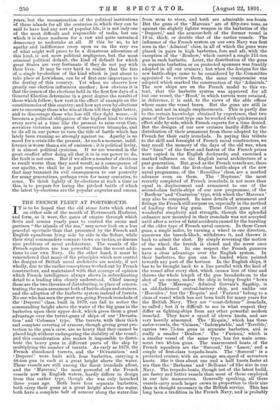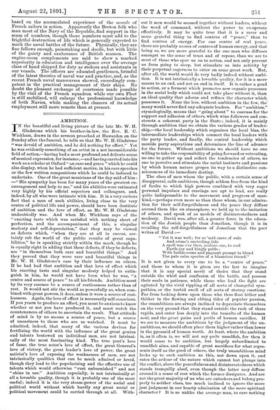THE FRENCH FLEET AT PORTSMOUTH.
IT is to be hoped that the old stone forts which stand on either side of the mouth of Portsmouth Harbour, and form, as it were, the gates of empire through which fleets and armies yearly pass to control the ocean and garrison " the islands of the sea," may never look on a less peaceful spectacle than that presented by the French and English squadrons lying side by side in the Solent, while their rival commanders compare views on tactics, or discuss nice problems of naval architecture. The vessels of the French squadron are less powerful than the recent addi- tions to our own Navy. On the other hand, it must be remembered that many of the principles which now control the designs of British naval architects are mainly, if not wholly, due to the earlier conceptions worked out by French constructors, and maintained with that courage of opinion which French intelligence always shows in subordinating detail to a leading idea clearly understood. Chief among these are the two theories of distributing, in place of concen- trating, the main armament both of battle-ships and cruisers, and the adoption of the barbette system instead of turrets. No one who has seen the great sea-going French ironclads of the Duperre ' class, built in 1879, can fail to notice the commanding height above the water of the big guns in the barbettes upon their upper deck, which gives them a great advantage over the turret-guns of ships of our Devasta- tion' and Colossus' type. The turrets, with their thick and complete covering of armour, though giving great pro- tection to the gun's crew, are so heavy that they cannot be placed high without endangering the stability of the vessel ; and this consideration also makes it impossible to distri- bute the heavy guns in different parts of the ship by multiplying the number of turrets. As early as 1879, the French abandoned turrets, and the Devastation ' and Duperre ' were built with four barbettes, carrying a 48-ton gun in each at a great height above the water. These vessels are still among the finest ironclads afloat, and the Marceau,' the most powerful of the French vessels now in English waters, hardly differs in design from this earlier type, though she was only launched three years ago. Both have four separate barbettes, both carry their guns at a great height above the water, both have a complete belt of armour along the water-line from stem to stern, and both are admirable sea-boats. But the guns of the Marceau ' are of fifty-two tons, as against the slightly lighter weapon in the barbettes of the Duperre,' and the armour-belt of the former vessel is 18 in. thick, or double that of the earlier vessels. The influence of the French system on our own Navy was first seen in the Admiral ' class, in all of which the guns were placed in pairs in high barbettes, fore and aft, with the exception of the Benbow,' which carried a single 111-ton gun in each barbette. Later, the distribution of the guns in separate barbettes or on protected sponsons was frankly adopted in all our cruisers ; but when the designs for the new battle-ships came to be considered by the Committee appointed to review them, the same compromise was adopted which marked the construction of the Admirals.' The new ships are on the French model to this ex- tent, that the barbette system was approved for all but one vessel, the Hood,' in which turrets were retained, in deference, it is said, to the views of the able officer whose name the vessel bears. But the guns are still in pairs, and not in single emplacements. This is partly due to the certain knowledge obtained by experience, that two guns of the heaviest type can be worked with quickness and effect side by side, which French experts for a time denied. But the designs of our new cruisers hardly differ in the distribution of their armament from those adopted by the French for their early ironclads. In paying this tribute to the skill and foresight of French naval constructors, we may recall the memory of the days of the old war, when the " lines " of the finest and fastest of the French prizes were copied in the English dockyards, and exercised a marked influence on the English naval architecture of a past generation. But, good as the French vessels are, there is no doubt that the first-class battle-ships of the new naval programme, of the ' Ramillies' class, are a marked advance even on them. The Neptune,' the most recently completed of French ironclads, is not more than equal in displacement and armament to one of the second-class battle-ships of our new programme, of the Barfleur ' and Centurion' type, with which the' Marceau ' may also be compared. In some details of armament and fittings the French still surpass us, especially in the method of loading their big guns. These Canet guns are of wonderful simplicity and strength, though the splendid ordnance now mounted in their ironclads was not accepted until after a series of fatal accidents caused by the bursting of the older type of French naval cannon. In these Canet guns, a single sailor, by turning a wheel in one direction, unscrews the breech-block, withdraws it, and throws it back to admit the shot. By simply reversing the motion of the wheel, the breech is closed and the screw once more made fast. In one respect the French gunners have a clear advantage over the English system. In their barbettes, the gun can be loaded when pointed towards any part of the horizon. In the English ships, it has to be brought back to a line parallel with the keel of the vessel after every shot, which causes loss of time and throws the whole length of the gun broadside-on to the shot of an enemy, unless the ship is being fought "bows on." The ' Marengo,' Admiral Gervais's flagship, is an old-fashioned central-battery ship, not unlike our Hercules ;' but the ' Requin ' and Furieux ' belong to a class of vessel which has not been built for many years for the British Navy. They are " coast-defence" ironclads, so called ; but it is difficult to see in what respect they differ as fighting-ships from any other powerful modern ironclad. They have a speed of eleven knots, and are very heavily armoured. The Requin,' which has three sister-vessels, the Caiman," Indomptable,' and Terrible,' carries two 75-ton guns in separate barbettes, and is really a smaller Benbow.' The ' Furieux,' which is a smaller vessel of the same type, has for main arma- ment two 48-ton guns. The unarmoured boats of the French squadron are the Surcouf,' the Lance,' and a couple of first-class torpedo-boats. The Surcouf ' is a protected cruiser, with an average sea-speed of seventeen knots. She is thus about one and a half knots faster at sea than the ' Barhams ' and Bellonas ' of like size in our Navy. The torpedo-boats, though not of the latest build, are faster and better vessels than most of those employed in our late manceuvres. Generally speaking, all these vessels carry much larger crews in proportion to their size than is thought necessary in the British service. This has long been a tradition in the French Navy, and is probably based on the accumulated experience of the morale of French sailors in action. Apparently the Breton folk who man most of the Navy of the Republic, find support in the sense of numbers, though those numbers must add to the frightful destruction of life which is generally expected to mark the naval battles of the future. Physically, they are fine fellows enough, painstaking and docile, but with little of the gaiety and exuberance of British seamen. The engine-room complements are said to show a marked superiority in education and intelligence over the average class of hand shipped for duty as stokers and assistants in our vessels. The officers are educated gentlemen, brimful of the latest theories of naval war and practice, and, as the recent French naval manceuvres showed, exceedingly com- petent in the practical management of their ships. No doubt the pleasant exchange of courtesies made possible by the visit of the French squadron while our own Fleet is still mobilised, will enlarge the professional knowledge of both Navies, while making the chances of its actual employment still more remote than at present.



































 Previous page
Previous page